Ian Melin-Jones
Metso Kappa Q analyzer replaces old technology at the Billerud Karlsborg mill in Sweden
By adopting Metso Kappa Analyzer technology, Billerud Karlsborg will benefit from faster and more accurate measurements to help improve pulp quality and optimize chemical usage
The Karlsborg mill in Sweden is installing a Metso Kappa Q to replace two old kappa analyzers in its bleached softwood kraft fiberline. With five sample points, pulp lignin content and brightness as well as fiber 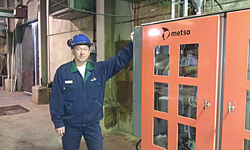 properties and shive content measurements, the Metso analyzer technology will provide opportunities for improved process optimization and quality control.
properties and shive content measurements, the Metso analyzer technology will provide opportunities for improved process optimization and quality control.
"The selection of supplier and analyzer was entirely based on the analyzer's performance and opportunities as well as Metso's well known organization for service, spares and support," states Peter Carlsson, Project Manager at the Billerud Karlsborg mill. Start-up is expected to be completed during October 2011.
Unique two-point calibration method
The Metso Kappa Q utilizes patented sweep technology to measure kappa and brightness with a unique two-point calibration method. Fiber and shive analysis at an early stage of pulping helps the user to produce more uniform pulp and provide more precise information for pulp grading and grade differentiation for various end use purposes.
Pulp production at Karlsborg dates back to the start of the 20th century. Today Billerud Karlsborg is one of the largest businesses in the region (Norrbotten), producing 130,000 tonnes of sack and kraft paper as well as 170,000 tonnes of market pulp. The mill comprises a pulp line, a paper machine, a coating machine and a drying machine for market pulp. Karlsborg is one of the Europe´s leading suppliers of white sack paper. White kraft paper and bleached long fibre sulphate pulp for sale on the open market are also produced at Karlsborg.
Offer: Paptech 2012 and PulPaper 2014
Sign up for Paptech Finland 2012 and get a discount on your participation at PulPaper 2014.
The next major international pulp and paper event held in Scandinavia will be PulPaper 2014, which coincides with the 100th anniversary of PI, the Paper Engineer's Association. Some 600 exhibitors and 12000 visitors are once again expected to participate in this world-class event.
Paptech plays an important role as a regional meeting place for the Finnish pulp and paper market between the large, international exhibitions.
Sign up for Paptech Finland 2012 and get a 10% discount on your participation at PulPaper 2014!
Exhibitors at Paptech Finland 2012 will automatically get a 10% discount on the space rental when signing up for PulPaper 2014. The offer is not valid for pavilions. The exhibitor cannot resell the stand.
Please contact Mr Marcus Bergström on + 358 44 56 24 524 or This email address is being protected from spambots. You need JavaScript enabled to view it. for more information.
Cascades Closes its Burnaby Containerboard Mill
Cascades Inc. (TSX: CAS), a leader in the recovery of recyclable materials and the manufacturing of green packaging and tissue paper products, announces that its Norampac division will close its containerboard mill located in Burnaby (British Colombia).
The Burnaby mill has an annual capacity of 128,000 short tons and specializes in the production of 100% recycled linerboard, medium and gypsum. Nearly 100 employees will be affected by the closure, which will be effective on December 1, 2011 at the latest. The mill's production will be redirected progressively towards other Norampac facilities.
“This decision was made to mitigate the negative impact of several factors such as the strength of the Canadian dollar, as well as very high labour and recycled fibre costs. In addition, the mill's profitability has been below our expectations for a few years and we could not pursue our operations under such conditions” stated Marc-Andre Dépin, President and Chief Executive Officer of Norampac.
Quebec mill fined $55,000 for releasing untreated water into river
The operator of the Stadacona pulp and paper mill in Quebec, Que., pleaded guilty to having released one million litres of untreated process water into the Saint-Charles River, in Quebec, and of having used a non-standard sampling method. The incidents occurred in December 2007, and violate the requirements of the Fisheries Act and the Pulp and Paper Effluent Regulations.
The penalty imposed on Stadacona General Partner Inc. is a payment of $49,500 to the Environmental Damages Fund to promote fish protection and the sound management and monitoring of fisheries and fish habitat. The court also imposed a $5,500 fine.
The Environment Canada investigation, completed in 2009, showed that a breakdown and poor functioning of the pumping station equipment and lack of maintenance of the equipment caused the release of harmful substances. Since then, the company has made a number of modifications to the facilities to prevent such an event from recurring.
The Stadacona mill has a thermomechanical pulp mill and deinking capacity. It produces newsprint, directory paper and linerboard. It is owned by White Birch Paper, currently undergoing restructuring under the Companies' Creditors Arrangement Act.
source: Pulp and Paper Canada
UPM Tervasaari PM 8 rebuild proceeds as planned
 In November 2010 UPM announced its response to the growing demand for label papers by increasing the label paper production capacity by almost 30,000 tonnes annually at its Tervasaari mill (PM 8) in Valkeakoski, Finland.
In November 2010 UPM announced its response to the growing demand for label papers by increasing the label paper production capacity by almost 30,000 tonnes annually at its Tervasaari mill (PM 8) in Valkeakoski, Finland.
"The rebuild of the Tervasaari PM 8 started in March 2011 and has proceeded as planned. The first phase in March 2011 brought already more capacity. The main phase takes place at the end of Q1 2012. In addition to capacity increase the investment enables UPM to widen the product portfolio towards thinner and lighter liners. The first new product will be a 45 gsm glassine,“ says Mr Jari Tamminen, Production Director of UPM Tervasaari.
UPM Tervasaari paper mill manufactures yearly some 360,000 tonnes of label, envelope and kraft papers. The mill employs about 400 people. PM 8 was built in 1996 and the machine produces label release base papers. Its previous rebuild was done in year 2006.
source: UPM
Analyze Nip Impressions Electronically
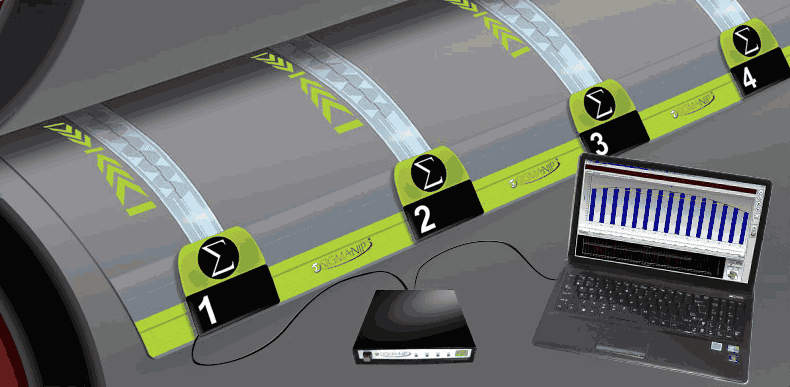
This email address is being protected from spambots. You need JavaScript enabled to view it.
Sigma-Nip® - an electronic nip analysis system, calculates and records nip width at multiple points across your rollers face length in real-time with unprecedented speed, accuracy and repeatability. The new Sigmanip® system is not only more accurate, but can handle higher pressures than ever previously attainable.
Sigma-Nip® presents a revolution in quality control. Now, for the first time ever the technician is able to accurately, efficiently and economically measure roller profiles and alignment condition. Sigma-Nip® consists of a series of thin-film resistive ink pressure transducers on a carrier sheet. As this carrier sheet is loaded in between your rollers the Windows based software assimilates the readings into easily interpretable graphical images - all in real-time.
What Is Sigma-Nip®
Sigma-Nip® consists of a series of sensor elements that are placed in between two contacting rollers. Immediately upon closing of rolls, the sensor begins recording precise nip width measurements allowing you to instantaneously determine whether your rollers are aligned properly and are squeezing together sufficiently. Sigma-Nip® is a real-time system. What that means is that your roller adjustments can be made WHILE the sensor is actually in the closed (non-rotating) nip. This allows for unprecedented flexibility and speed.
Designed For Productivity
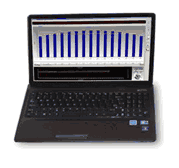 Sigma-Nip® comes complete with everything you need to quickly and accurately take nip impressions. Sigma-nip®’s software is so intuitive and user friendly within minutes even an inexperienced user will benefit from it’s powerful reports.
Sigma-Nip® comes complete with everything you need to quickly and accurately take nip impressions. Sigma-nip®’s software is so intuitive and user friendly within minutes even an inexperienced user will benefit from it’s powerful reports.
Sigma-Nip® is designed with the intention of being used during routine maintenance or set up and is quickly disposed across the roller surface by just one person. The system is modular and portable and quickly interfaces to the USB port on any standard Windows laptop.
Why Use Sigma-Nip®
Proper roller alignment and pressure level are critical for both print clarity and web control. An evenly loaded roller set is much less likely to cause costly web breaks and sheet “walking”, wrinkles, or fold-overs. Simply by virtue of routine tests, Sigma-Nip allows the user to greatly extend blanket life.
Sigma-Nip® Technology
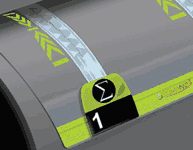 Through the application of sophisticated mathematical algorithms, Sigma-Nip® is able to discern the contact profile of the machine’s cross direction with a higher degree of accuracy never before attainable. Each sensor is individually calibrated, serialized and carefully assembled to exacting tolerances. The sensor is designed to withstand repeated high pressures, conform to radiused surfaces and routine exposure to grease, liquids and inks.
Through the application of sophisticated mathematical algorithms, Sigma-Nip® is able to discern the contact profile of the machine’s cross direction with a higher degree of accuracy never before attainable. Each sensor is individually calibrated, serialized and carefully assembled to exacting tolerances. The sensor is designed to withstand repeated high pressures, conform to radiused surfaces and routine exposure to grease, liquids and inks.
What people are saying about Sigma-Nip® ...
"Sigma-Nip® has come a long way from concept to a reliable, easy to use nip profile measuring tool. It has successfully bridged the gap between conventional carbon paper impressions and the first generation of electronic nip devices. Being able to save and review the entire real-time data from nip closing to nip opening is extremely useful, however, the ability to correlate accurate nip width data to roll deflection is an exceptional benefit." — Mike Stoltz, Metso Paper USA
"Sigma-Nip® is an extremely helpful tool for troubleshooting in printing presses and has saved my colleagues and I significant amounts of time. It allows us to assess what is happening where the actual printing takes place and quickly get to the source of the problem. This is a new tool for us and the industry, but I foresee more and more printers starting to use this system as people begin to see its advantages." — Don Jordan, Abitibi Consolidated
A&R Carton is reorganising its production in the Nordic region
The packaging group A&R Carton is optimising its production in the Nordic region. The management of the Swedish company has today begun negotiations with the trade union representatives to close the factory in Norrköping. The plans affect around 80 employees. A further 12 people were given notice earlier in the year.
"Competition on the European folding carton market is tough and it is not possible to make the products we make today in a competitive manner with the cost structure in the plant in Norrköping," says Per Lundeen, Group CEO of A&R Carton AB.
The factory has been unprofitable for many years. Despite numerous efficiency enhancements and investments in operations, it has not been possible to reverse the trend. The volumes that are currently produced in the factory will gradually be transferred primarily to A&R Carton's plants in Lund and Finland in 2012. Deliveries to customers will continue without interruption.
"We regret that we are forced to make employees redundant but it is necessary to maintain our competitiveness. By concentrating production on specialised factories, we will create a number of competence centres which will make us more efficient and give us better opportunities to develop new products. This will benefit our customers, which will also protect the jobs in our other plants," says Per Lundeen.
Metso signs roll service agreement with Holmen Paper
Metso has signed a roll service agreement with Holmen Paper for their Hallsta Paper Mill in Sweden. The value of the agreement will not be disclosed.
With this three-year agreement, which became effective as of September 1, 2011, Metso will be responsible for all mechanical roll services at the Hallsta Paper Mill. Roll grinding and part of mechanical roll maintenance will be carried out at Metso’s workshops in Borlänge and Karlstad, Sweden. A Metso maintenance engineer will be based at the Hallsta mill to serve as a link between Metso and the mill. Metso’s workforce will also include two maintenance technicians.
Daniel Peltonen, Technical Manager at the Hallsta Paper Mill, says: “We have high expectations for this agreement, and not just regarding the quality of roll grinding and maintenance efficiency. We also expect it to have positive effects on productivity.”
Holmen Paper was established 400 years ago and is one of Europe’s leading manufacturers of printing paper. The three paper machines at the Hallsta Paper Mill produce MF magazine paper and a range of special qualities of wood-containing printing paper. The annual production capacity is 670,000 tons.
UPM awarded FSC certificate for company's forests in Finland
UPM is the first Finnish company to be awarded a certificate for complying with the new FSC (Forest Stewardship Council) standard. The FSC certificate covers around half of UPM's forests in Finland. UPM's forests have previously been awarded a PEFC (Programme for the Endorsement of Forest Certification Schemes) certificate.
"FSC certification of Finnish forests further expands UPM's portfolio of eco-labelled products. We already have the markets' most extensive selection of paper products with the EU Ecolabel. Forest certificates, such as FSC and PEFC are a guarantee to our customers that our wood fibre comes from sustainably managed forests," says Thomas Ehrnrooth, Vice President, Marketing, Paper.
The first UPM products manufactured from FSC-certified Finnish fibre will be available on the market in autumn 2011.
An agreement on the new Finnish FSC standard and its requirements was concluded during negotiations between environmental organisations and the forest industry in autumn 2010 and a certificate of compliance with the new standard has been available for Finnish forests as of May 2011. UPM started certification preparations at the beginning of this year. The FSC certificate was granted by Soil Association Woodmark.
"WWF and UPM have been working closely for a long time and I am pleased to see that UPM is setting an example in FSC certification for other Finnish companies. We hope that more forest owners will start to adhere to the more ecologically stringent FSC standard," says Liisa Rohweder, President of WWF Finland.
"FSC certification is a natural continuation for the development of UPM's forestry. We want to develop sustainable forest management and make our business more transparent," stresses Timo Lehesvirta, Director, Environment.
UPM monitors the origin of all the fibre it sources and strives to maximise the use of certified fibre. In 2010, 79% of the fibre used by UPM was certified. All forests owned by UPM have a PEFC, FSC or SFI certificate.
Metso introduces UV measurement in all its inline brightness sensors to pulp and paper
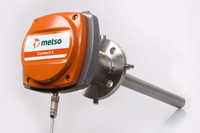 UV measurement is now a standard part of Metso's inline brightness sensors to optimize chemical costs at DIP/RCF plants. The previous two inline brightness sensor models, Cormec5 and Cormec5 X, with different measurement capabilities will merge and become one. The new inline sensor with an enhanced measurement capability will carry the name Metso Cormec5 X. In addition to brightness and UV+ brightness, it also measures other important optical pulp properties, such as residual ink and color.
UV measurement is now a standard part of Metso's inline brightness sensors to optimize chemical costs at DIP/RCF plants. The previous two inline brightness sensor models, Cormec5 and Cormec5 X, with different measurement capabilities will merge and become one. The new inline sensor with an enhanced measurement capability will carry the name Metso Cormec5 X. In addition to brightness and UV+ brightness, it also measures other important optical pulp properties, such as residual ink and color.
Metso Cormec5 X with its UV measurement has been well received by European DIP/RCF plants. Fluorescence and UV+ brightness values are typically used for measuring the quantity of the optical brightening agent (OBA) in the incoming raw material and for OBA dosage control in stock preparation. As OBAs are fairly expensive and can be harmful to health, mills have been able to optimize their chemical costs with continuous inline measurement information while achieving set quality targets. In addition, the mills have been able to ensure that specific grades, such as tissue and hygienic papers, do not hold any chemical residues.
The UV-based measurement can be used together with the industry standard brightness, effective residual ink content (ERIC) and CIELAB color measurements to achieve full benefit from a single-point inline measurement. Based on experiences at paper mills, Metso Cormec5 X has also proven its capabilities in paper machine approach systems when controlling OBA and color dosage during web breaks and process startups when measurement results from a scanner are not available. During a normal run, it provides fast feedback for paper machine quality controls together with traditional scanner measurements.
